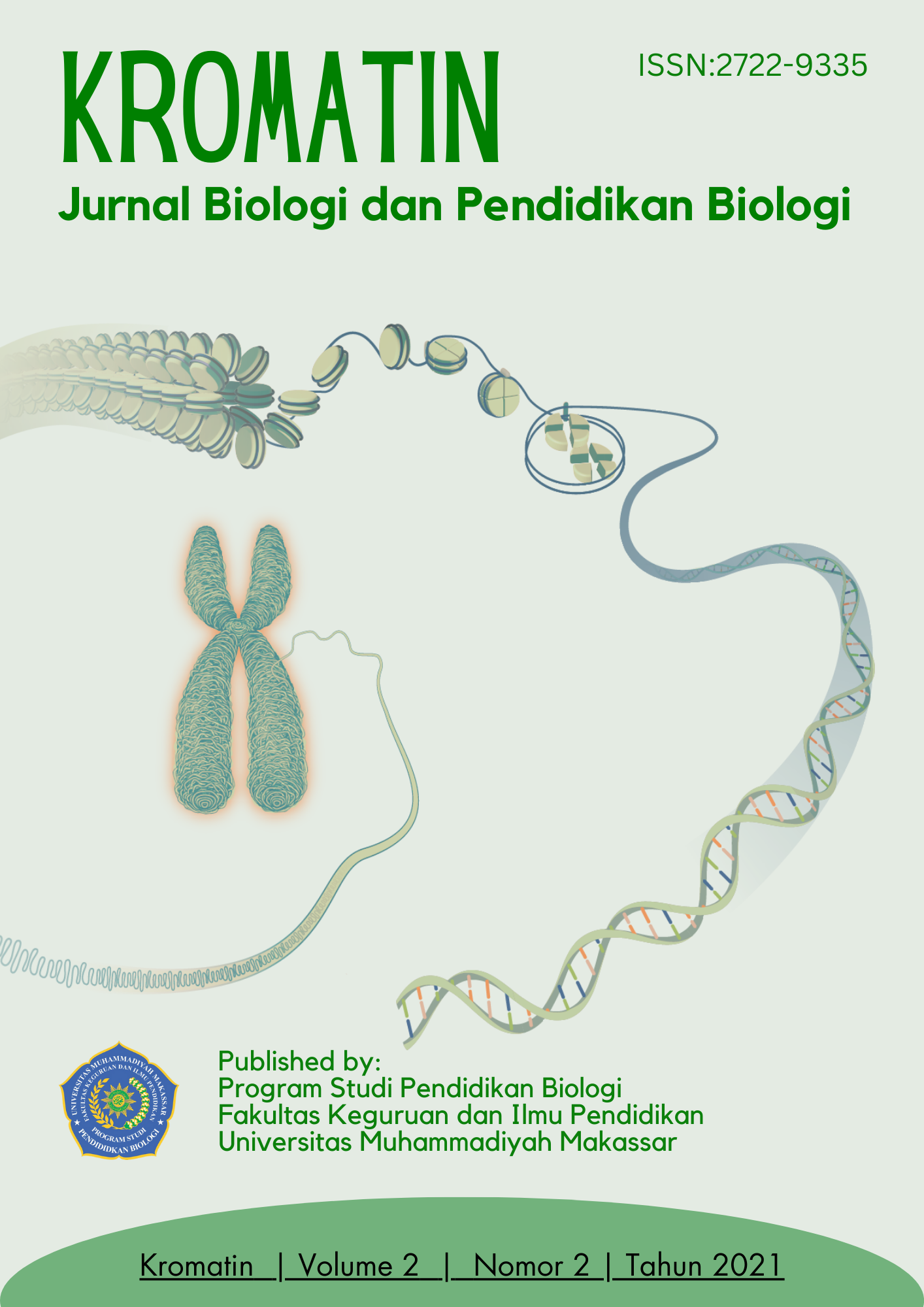Uji Efektivitas Sari Batang Serai Dapur Cymbopogon Citratus Sebagai Insektisida Alami Terhadap Mortalitas Nyamuk Aedes aegypti
Abstract
Generally people use chemical insecticides to kill mosquitoes. Recently, it is known that many chemical compounds found in natural materials can be used as natural insecticides. This study aims to determine the effectiveness of lemongrass stalk extract as a natural insecticide against the mortality of Aedes aegypti and to determine at a certain concentration lemongrass extract is effective as a natural insecticide. The research design used was a completely randomized design (CRD). The treatments used in this study were eight variations, namely K1 (10%), K2 (20%), K3(30%), K4(40%), K5(50%), K6(60%), K7(70% ), K8(80%), 2 controls, K+ (Baygon), K- (Aquadest) and 2 replications with the test mosquito was Aedes aegypti which was bred in the Biology Laboratory, University of Muhammadiyah Bulukumba. Observations were made for 3 hours, namely the first 1 hour, the second 1 hour, and the third 1 hour. Data analysis in this study used ANOVA Analysis and Probit Analysis to determine Lethal Concentration (LC50) and Lethal Time (LT50). The results obtained from this study are that all variations in the concentration used can have an effect on mosquito mortality with the most effective concentration being a concentration of 80% which can kill 100% of the test mosquito samples. Probit analysis of mosquito mortality percentage data showed lemongrass extract as a natural insecticide was effective in killing 50% of the test mosquito population with an LC50 value at a concentration of 40.886% and the time needed to kill 50% of the test mosquito population was 1.003 hours. The conclusion in this study was that the use of lemongrass (Cymbopogon citratus) extract was effective as a natural insecticide against the mortality of Aedes aegypti, which was effective at a concentration of 80% (K8) equivalent to control treatment + use of chemicals (Baygon) which killed 100% of the tested mosquitoes. Keywords: lemongrass stalk extract (Cymbopogon citratus), Aedes aegypti, natural insecticideReferences
Amalinda,M. Novasari, Sasongkowati dan Retno. 2017. Efektivitas Larutan Biji Srikaya (Annona Squamosa L.) Sebagai Insektisida Terhadap Kematian Nyamuk Aedes aegypti Dengan Metode Liquid Electric. Jurnal Kesehatan Lingkungan. Vol; 9(2) : 200–208
Anam, K. I. Ma’rufi dan D. Wahyuni. 2019. Pengaruh Konsentrasi dan Time Efek Sari Batang Serai Dapur (Cymbopogon nardus) dalam bentuk spray sebagai insektisida nyamuk Aedes aegypti. Journal Multi disciplinary. Vol: 1. No. 1.
Asmaliyah., Wati, E. E., Utami, S., Mulyadi, K., Yudhistira., & Sari, F. W. (2010). Pengendalian Tumbuhan Penghasil Pestisida Nabati dan Pemanfaatannya Secara Tradisional. Kementerian Kehutanan.
Ishak, N. I. Dan Kasman, C. (2019). Efektivitas Ekstrak Kulit Buah Limau Kuit (Citrus Amblycarpa) sebagai Larvasida Aedes Aegypti Instar III. Jurnal MKMI. Vol :15(3), 302–310.
Munarso, J., Yusniarti., Suyati, S. E., & Budiharto, A. (2012). Pestisida Nabati. Bogor: Pusat Penelitian dan Pengembangan Perkebunan.
Qinahyu, W.D. 2016. Uji Kemampuan Anti Nyamuk Alami Elektrik Mat Serbuk Bunga Sukun (Artocarpus altilis) di Masyarakat (Skripsi). Semarang: Universitas Semarang.
Rahmawati, U, M. Gustina dan R. Mirza. 2020. Efektivitas Anti Nyamuk Alami Elektrik Mat Serai Dapur (Cymbopogon Nardus) Dalam Mematikan Nyamuk Aedes Aegypti. Journal of Nursing and Public Health, Vol. 8(2), 100-107.
Sastriwan, A. 2014. Efektivitas serai dapur. (Cymbopogon citratus) sebagai larvasida pada larva nyamuk Aedes sp instar III/IV. Jakarta.
Susanti dan Boesri. 2012. Toksisitas Biolarvasida Ekstrak Tembakau dibandingkan Dengan Ekstrak Zodia Terhadap Jentik Vektor Demam Berdarah Dengue. Jurnal Buletin penelitian Kesehatan. Vol: 40 (No.2).
Wibawa, R.R.. 2012. Potensi Ekstrak Biji Mahkota Dewa (Phaleria macrocarpa) Sebagai Insektisida Terhadap Nyamuk Aedes aegypti dengan Metode Semprot (Skripsi). Jember: Universitas Jember Fakultas Kedokteran.
Widiyanti, NLM, Mulyadiharje S (2004) Uji toksisitas jamur Metarliizium anisopliae terhadap larva nyamuk Aedes aegypti. Media Litbang Kesehatan14(3): 25-31.
Widoyono. 2011. Penyakit Tropis : Epidemiologi, Penularan, Pencegahan, dan Pemberantasannya. Jakarta: Erlangga.
Yunita, E. A., Suprapti, N. H., & Hidayati, J. W. (2009). Pengaruh Ekstrak Daun Teklan (Eupatorium riparium) terhadap Mortalitas dan Perkembangan Larva Aedes aegypti. Jurnal Bioma, 11 (1): 11-17.
Downloads
Published
Issue
Section
License
Authors who publish with this journal agree to the following terms:
1. Authors retain copyright and grant the journal right of first publication with the work simultaneously licensed under a Creative Commons Attribution 4.0 Internasional License that allows others to share the work with an acknowledgement of the work's authorship and initial publication in this journal.
2. Authors are able to enter into separate, additional contractual arrangements for the non-exclusive distribution of the journal's published version of the work (e.g., post it to an institutional repository or publish it in a book), with an acknowledgement of its initial publication in this journal.
3. Authors are permitted and encouraged to post their work online (e.g., in institutional repositories or on their website) prior to and during the submission process, as it can lead to productive exchanges, as well as earlier and greater citation of published work.
Licence:
Authors are free to:
1. Share: Copy and redistribute the material in any medium or format
2. Adapt: Remix, transform, and build upon the material for any purpose, even commercially.
The licensor cannot revoke these freedoms as long as the authors follow the license terms, which include the following:
1. Attribution: Authors must give appropriate credit, provide a link to the license, and indicate if changes were made. Authors may do so in any reasonable manner, but not in any way that suggests the licensor endorses the authors or authors’ use.
2. No additional restrictions: Authors may not apply legal terms or technological measures that legally restrict others from doing anything the license permits.
This work is licensed under a licensed under a Creative Commons Attribution 4.0 Internasional License/ CC BY 4.0.


